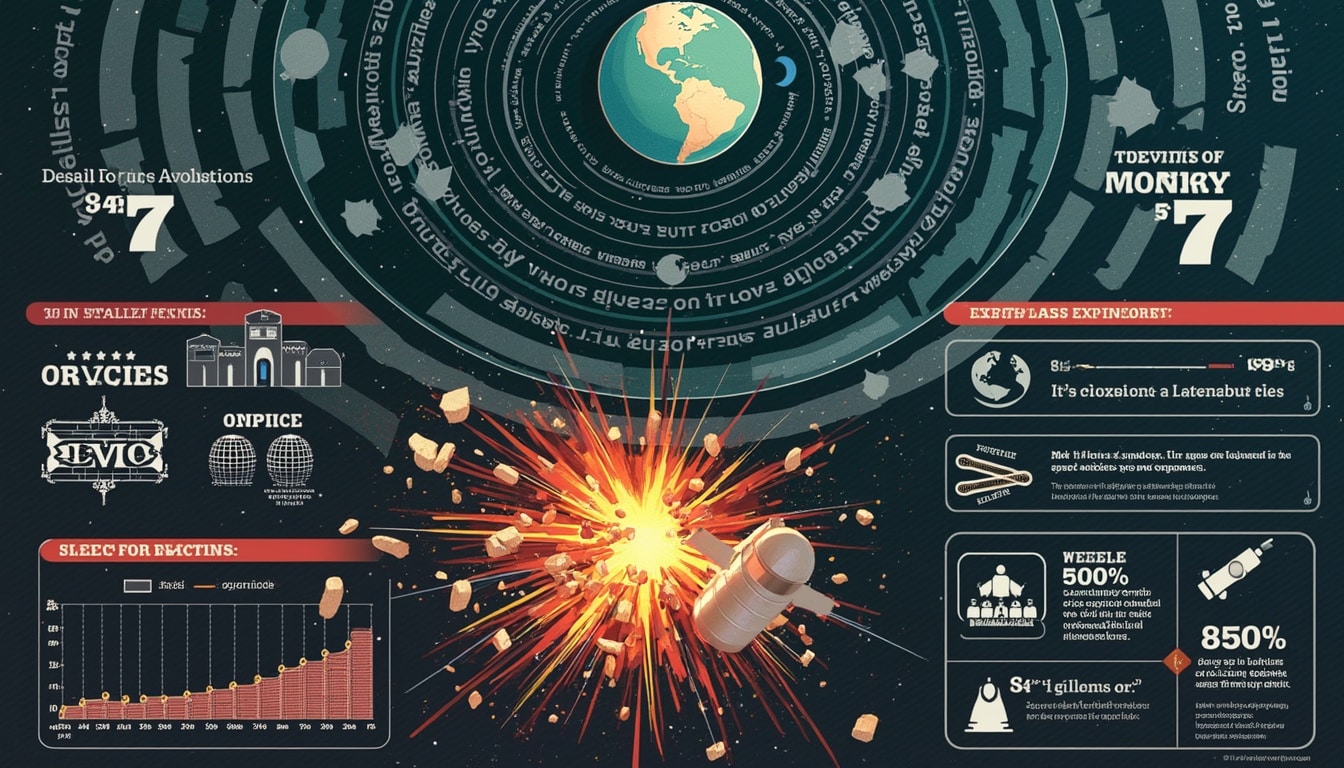The aftermath of SpaceX’s Starship Flight 7 explosion on January 16, 2025, has raised significant concerns regarding its environmental consequences. As observers witnessed debris raining down over the Caribbean, scientists hurried to analyze not only the physical remnants of the rocket but also the atmospheric pollutants resulting from the incident. The event’s implications extend beyond immediate damage, invoking concerns about long-term air quality, the integrity of the ozone layer, and the overall impact on global climate.
This blog post delves into the intricate details of the environmental fallout from the Starship explosion, exploring the nuances of how such occurrences can influence our atmosphere. By examining various scientific estimates related to emissions and conducted research, clarity can be gained about the challenges posed by modern spaceflight endeavors.
Understanding the Mechanisms of Pollution from Rocket Explosions
Rocket explosions are not merely spectacular events; they are also significant sources of atmospheric pollution. As SpaceX’s Starship exploded at approximately 90 miles above earth, estimations by experts like NASA’s Jonathan McDowell indicated that around 85 tons of rocket mass plummeted back to earth. Understanding how this debris contributes to atmospheric pollution requires delving into specific mechanisms at work during such high-altitude events.
The Role of Nitrogen Oxides
The Starship explosion likely released up to 40 metric tons of nitrogen oxides (NOx) into the atmosphere. Nitrogen oxides are notorious for their damaging effects on the ozone layer. Formed when fuel combusts at high temperatures, these gases exist in various forms, including nitrogen dioxide (NO2) and nitric oxide (NO). Their presence in the upper atmosphere is concerning as they can directly contribute to ozone depletion, an essential shield protecting life on earth. In the context of rising satellite launches and space debris, every explosion carries the risk of increasing these harmful gases in our atmosphere.
Metallic Particulate Matter and Their Effects
In addition to nitrogen oxides, the Starship incident emitted around 45.5 metric tons of metallic oxides. One might wonder how metals from rocket debris can become airborne pollutants. Upon reaching the upper atmosphere, high-speed ascent and subsequent explosions create finely divided particles of metal, which can linger in the stratosphere for extended periods. Industries and vehicular emissions have also been known contributors to the presence of metals in our atmosphere, adding another layer of complexity to the conversation surrounding the effects of rocket launches.

Quantifying the Environmental Impact of Starship Flight 7
Following the explosion, researchers like Connor Barker from University College London provided preliminary estimates aimed at understanding the scope of pollution and its potential environmental consequences. Such estimates indicate that the metallic air pollution produced could equate to one-third of the total amount generated by meteorites burning up in our atmosphere annually. This measurement places rocket launches in a broader environmental context.
The Data Behind the Estimates
Barker’s investigative work highlights the unique challenge posed by understanding the proportions of pollutants released during rocket explosions versus natural occurrences like meteor showers. Discerning actual figures is intricate, as researchers must evaluate how much debris truly survived the explosive disintegration and what fraction of it was consumed by the atmosphere. Yet the implications tie into larger conversations around the increasing number of satellite launches and frequent space missions, reminding us of the environmental uncertainties tied to the burgeoning space industry.
Potential Long-term Effects on the Ozone Layer
The concern extends beyond immediate visible pollution. With most nitrogen oxides released during rocket events harming the ozone layer, their cumulative effects could pose significant risk in the coming years. For instance, unchecked recurrent missions could outweigh the recoverability of the ozone layer, previously considered inert to the destructive capacities of human activities. Thus scientists correlate the number of missions with potential damage to the atmosphere, highlighting the need for careful regulatory frameworks governing space launches.
Discussed studies indicate a pressing need to develop sustainable practices for rocket launches, directing endeavors toward reducing harmful emissions. Several companies are already exploring greener propulsion systems and methodologies to mitigate atmospheric pollution, but tangible changes must expand across the industry rapidly.
Environmental Policies in Spaceflight
The evolution of environmental policies surrounding spaceflight remains critical and timely. As companies like SpaceX lead the charge in commercial space exploration, not only is success measured by project launches, but responsibility towards Earth and its atmosphere is paramount. Institutions such as the FAA (Federal Aviation Administration) are now implementing regulatory measures aiming at assessing the environmental impact of space activities.
For instance, following the Starship Flight 7 explosion, the FAA mandated an investigation into the explosion’s aftermath, recognizing the urgency of understanding these impacts in detail. The establishment of stringent regulations is a necessary step forward to ensure that the expanding space race does not compromise the ecological fitness of our planet. By integrating environmental assessments into the launch approval process, space agencies and companies may foster a culture of accountability within the industry.

The Broader Implications of Space Debris on Our Atmosphere
The consequences of rocket launches extend beyond atmospheric pollution to broader implications tied to space debris. Global increases in satellite launches come with a cascade of environmental challenges, leading us to question the sustainability of our ventures into the cosmos.
Historical Context of Space Debris
With the current rise of commercial spaceflight, space debris has also increased exponentially. Past missions have only begun to reveal the issues associated with junk orbiting the Earth. At present, more than 30,000 pieces of recognized debris are tampering with orbital pathways, with many pieces lingering in the upper atmosphere for decades or longer. The historical trajectory highlights how modern operations may soon yield a swathe of new debris in the wake of explosive incidents like that experienced by SpaceX.
Responsible Practices Moving Forward
Ensuring responsible practices must now become a focal point for the industry. Vigilance regarding the sustainability of launches extends not only prior to liftoff but also encompasses lifecycles of hardware. Emerging technologies such as debris tracking and active removal solutions are gaining traction among stakeholders in aerospace. While still in early development, these technologies promise to revolutionize space safety, minimizing the accumulation of space debris.
Ultimately, the dialogue surrounding responsible spaceflight must remain active, encouraging discussions among scientists, policymakers, and commercial entities to spearhead sustainable measures while exploring the final frontier.

Community and Global Perspectives on Space Pollution
As awareness grows, community and global perspectives on space pollution are sparking discussions among citizens, scientists, and governments alike. The convergence of technology and human impact on the environment has fostered a collective responsibility toward addressing these new challenges.
The Role of Citizen Scientists
Civil engagement is a cornerstone of how communities can address the challenges posed by space pollution. Citizen scientists contribute their measurements and observations, sparking important questions around the safety of launches in their areas. This collaborative approach can lead to local advocacy efforts aimed at reinforcing environmental priorities within the tech industry.
Global Cooperation for Sustainable Practices
Global cooperation is paramount as nations strive to outline the frameworks that govern space endeavors. Initiatives aimed at sharing knowledge and best practices can lead to more informed decisions about operational standards. Cross-border collaboration will shape the narrative as we embark on this journey into the stars, ensuring that our explorations do not come at the cost of our planet.

Final Thoughts on SpaceX’s Environmental Conundrum
The quest for progress in space exploration remains exhilarating and complex. As the industry surges forward, the balance between innovation and environmental preservation emerges as a critical discussion. The events surrounding SpaceX’s Starship Flight 7 essentially serve as a reminder of the responsibilities accompanying high-stake technological advancements.
Raising awareness of atmospheric pollution, the quest for sustainable practices, and the need for regulatory oversight will become the guiding principles for future endeavors. The skies above us must not only be a space for exploration but a sanctuary worth protecting for generations to come.




Leave a Reply